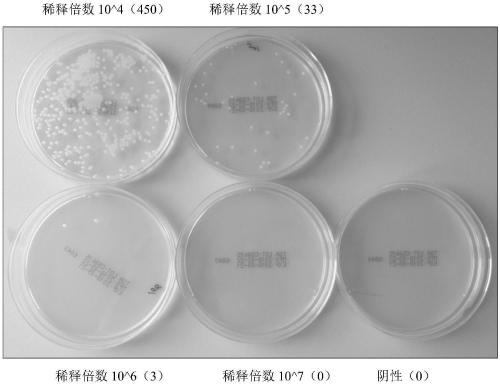Method for detecting bacteria by amplifying conserved region sequence of 16S rDNA
A technology for sequence detection and conserved regions, applied in the field of bioengineering, can solve the problems of heavy workload, long time, and prone to false negatives, and achieve the effects of convenient operation, high sensitivity, and significant technological progress.
- Summary
- Abstract
- Description
- Claims
- Application Information
AI Technical Summary
Problems solved by technology
Method used
Image
Examples
Embodiment 1
[0020] 1. Preparation of primers and standards
[0021] 1. The forward primer of the present invention: 5'-cagcagccgcggtaatac-3' (shown in SEQ ID NO.1); or
[0022] 5'-cagcagccgcggtaattc-3' (shown in SEQ ID NO.2); or
[0023] 5'-cagccgccgcggtaatac-3' (shown in SEQ ID NO.3); or
[0024] 5'-cagccgccgcggtaattc-3' (shown in SEQ ID NO.4); or
[0025] 2. Reverse primer: 5'-ggactaccagggtatctaat-3'. Synthesized by Sunny Corporation. Primers were dissolved in water to a concentration of 10 μM.
[0026] 3. The standard product of the present invention is the pUC57 plasmid containing the partially conserved region sequence of 16S rDNA, synthesized by Sunny Company. The base number of pUC57 is 2710bp. 16S rDNA部分保守区序列为ccgtgc cagcagccgc ggtaatacggagggtgcaag cgttaatcgg aattactggg cgtaaagcgc acgcaggcgg tttgttaagt cagatgtgaaatccccgggc tcaacctggg aactgcatct gatactggca agcttgagtc tcgtagaggg gggtagaattccaggtgtag cggtgaaatg cgtagagatc tggaggaata ccggtggcga aggcggcccc ctggacgaagactgacgctc agg...
PUM
 Login to View More
Login to View More Abstract
Description
Claims
Application Information
 Login to View More
Login to View More - R&D
- Intellectual Property
- Life Sciences
- Materials
- Tech Scout
- Unparalleled Data Quality
- Higher Quality Content
- 60% Fewer Hallucinations
Browse by: Latest US Patents, China's latest patents, Technical Efficacy Thesaurus, Application Domain, Technology Topic, Popular Technical Reports.
© 2025 PatSnap. All rights reserved.Legal|Privacy policy|Modern Slavery Act Transparency Statement|Sitemap|About US| Contact US: help@patsnap.com



